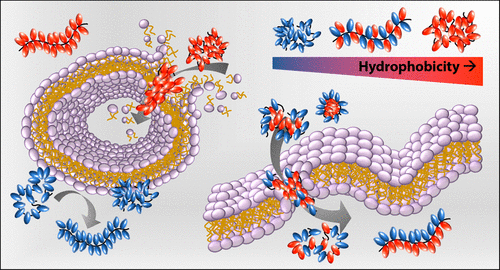当前位置:
X-MOL 学术
›
Biomacromolecules
›
论文详情
Our official English website, www.x-mol.net, welcomes your feedback! (Note: you will need to create a separate account there.)
Polymers for Biomedical Applications: The Importance of Hydrophobicity in Directing Biological Interactions and Application Efficacy
Biomacromolecules ( IF 6.2 ) Pub Date : 2021-09-08 , DOI: 10.1021/acs.biomac.1c00434 Amanda K Pearce 1 , Rachel K O'Reilly 1
Biomacromolecules ( IF 6.2 ) Pub Date : 2021-09-08 , DOI: 10.1021/acs.biomac.1c00434 Amanda K Pearce 1 , Rachel K O'Reilly 1
Affiliation

|
The past decades have seen significant research effort in the field of polymers for a range of biomedical applications, driven by the promising prospect of these materials for realizing next generation therapeutics in the clinic. In this regard, it is widely accepted that polymer properties such as chemistry, charge, and block composition, as well as properties of their self-assemblies including size, shape, surface chemistry, and biodegradation, all influence and direct their interactions with cells and biological membranes. In particular, polymer hydrophobicity is a property of interest, with growing evidence demonstrating the significant impact that hydrophobic interactions with lipid membranes and proteins can have on biomaterial application efficacy within the body. However, to date, this phenomenon has been relatively underexplored, and therefore there exists no clear universal understanding to direct polymer design. In this Perspective, we highlight important contributions to this field, focusing on seminal studies which investigate experimentally and theoretically how incorporation of hydrophobic moieties within polymer systems can influence their ultimate properties when used in biomedical applications. In this way, we aim to signify future directions in the design of highly performing polymers for biomedicine, making a case for the importance of standardized computational modeling to achieve widely applicable conclusions and facilitate future translational efforts.
中文翻译:

生物医学应用聚合物:疏水性在指导生物相互作用和应用功效方面的重要性
在过去的几十年里,在聚合物领域为一系列生物医学应用进行了大量研究,这些材料在临床中实现下一代治疗的前景广阔。在这方面,人们普遍认为聚合物的特性,如化学、电荷和嵌段组成,以及它们自组装的特性,包括尺寸、形状、表面化学和生物降解,都会影响和指导它们与细胞和生物膜。特别是,聚合物疏水性是一个令人感兴趣的特性,越来越多的证据表明疏水性与脂质膜和蛋白质的相互作用可能对体内生物材料的应用功效产生重大影响。然而,迄今为止,这种现象的研究相对不足,因此,对直接聚合物设计没有明确的普遍理解。在这个观点中,我们强调了对该领域的重要贡献,重点是开创性研究,这些研究从实验和理论上研究了疏水部分在聚合物系统中的加入如何影响其在生物医学应用中的最终性能。通过这种方式,我们旨在指明用于生物医学的高性能聚合物设计的未来方向,说明标准化计算建模的重要性,以得出广泛适用的结论并促进未来的转化工作。专注于开创性研究,从实验和理论上研究疏水部分在聚合物系统中的结合如何影响其在生物医学应用中的最终性能。通过这种方式,我们旨在指明用于生物医学的高性能聚合物设计的未来方向,说明标准化计算建模的重要性,以得出广泛适用的结论并促进未来的转化工作。专注于开创性研究,从实验和理论上研究疏水部分在聚合物系统中的结合如何影响其在生物医学应用中的最终性能。通过这种方式,我们旨在指明用于生物医学的高性能聚合物设计的未来方向,说明标准化计算建模的重要性,以得出广泛适用的结论并促进未来的转化工作。
更新日期:2021-11-08
中文翻译:

生物医学应用聚合物:疏水性在指导生物相互作用和应用功效方面的重要性
在过去的几十年里,在聚合物领域为一系列生物医学应用进行了大量研究,这些材料在临床中实现下一代治疗的前景广阔。在这方面,人们普遍认为聚合物的特性,如化学、电荷和嵌段组成,以及它们自组装的特性,包括尺寸、形状、表面化学和生物降解,都会影响和指导它们与细胞和生物膜。特别是,聚合物疏水性是一个令人感兴趣的特性,越来越多的证据表明疏水性与脂质膜和蛋白质的相互作用可能对体内生物材料的应用功效产生重大影响。然而,迄今为止,这种现象的研究相对不足,因此,对直接聚合物设计没有明确的普遍理解。在这个观点中,我们强调了对该领域的重要贡献,重点是开创性研究,这些研究从实验和理论上研究了疏水部分在聚合物系统中的加入如何影响其在生物医学应用中的最终性能。通过这种方式,我们旨在指明用于生物医学的高性能聚合物设计的未来方向,说明标准化计算建模的重要性,以得出广泛适用的结论并促进未来的转化工作。专注于开创性研究,从实验和理论上研究疏水部分在聚合物系统中的结合如何影响其在生物医学应用中的最终性能。通过这种方式,我们旨在指明用于生物医学的高性能聚合物设计的未来方向,说明标准化计算建模的重要性,以得出广泛适用的结论并促进未来的转化工作。专注于开创性研究,从实验和理论上研究疏水部分在聚合物系统中的结合如何影响其在生物医学应用中的最终性能。通过这种方式,我们旨在指明用于生物医学的高性能聚合物设计的未来方向,说明标准化计算建模的重要性,以得出广泛适用的结论并促进未来的转化工作。


























 京公网安备 11010802027423号
京公网安备 11010802027423号